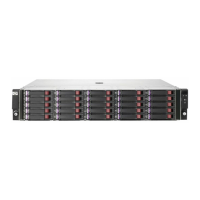RAID meth-
od
Data redund-
ancy
Best practicesSummary
Striping and
parity
High
RAID6 is most useful when data
loss is unacceptable but cost is
also an important factor. The
probability that data loss will oc-
cur when an array is configured
with RAID6 is less than it would
be if it was configured with
RAID5. However, write perform-
ance is lower than RAID5 be-
cause of the two sets of parity
data.
Like RAID5, RAID6 gener-
ates and stores parity inform-
ation to protect against data
loss caused by drive failure.
With RAID6, however, two
different sets of parity data
are used, allowing data to
be preserved if two drives
fail.
RAID6
Disk drive sizes and types
RAID arrays should be composed of disk drives of the same size and performance capability. When
drives are mixed within a disk enclosure, the usable capacity and the processing ability of the entire
storage sub-system is affected. For example, when a RAID array is composed of different sized drives,
the RAID array defaults to the smallest individual drive size, and capacity in the larger drives goes
unused.
Spare disks
Spares are disks that are not active members of any particular array, but have been configured to
be used when a disk in one of the arrays fails. If a spare is present, it will immediately be used to
begin rebuilding the information that was on the failed disk, using parity information from the other
member disks. During the rebuilding process, the array is operating in a reduced state and, unless it
is a RAID6 or RAID1+0 array, it cannot tolerate another disk failure in the same array. If another disk
fails at this time, the array becomes inaccessible and information stored there must be restored from
backup.
After the rebuild of the data onto the spare is completed, when a replacement drive is inserted to
replace the failed drive, the system will automatically transfer the data from the spare onto the
replacement drive and return the spare to an available-spare state. It is important to note that the
process of rebuilding the spare or the replacement drive must not be interrupted or the process will
be aborted.
Some administrators have multiple spare disks, so that multiple arrays can experience failure and
successfully recover, before administrative intervention would be required to replace the spare or
failed disk. When assigning a spare to an array, the administrator chooses which arrays and how
many arrays are protected by that spare.
Array sizing
As a general rule, the greater the number of drives that are included in an array, the greater the
performance level that can be achieved. However, performance considerations are offset by fault
tolerance considerations. The greater the number of drives in an array, the higher the probability of
one or more disk failures in that array. The administrator must strike a balance between performance
and fault tolerance.
Installation28
